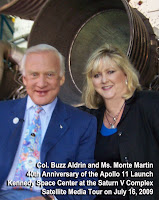 Aldrin recalls moon mission on 40th anniversary
Aldrin recalls moon mission on 40th anniversary 
Updated Thursday, July 16, 2009 10:07 AM ET
(Transcript of Media Tour-video not available) CTV.ca News Staff
Buzz Aldrin, an astronaut on Apollo 11, speaks on CTV's Canada AM from the Kennedy Space Center in Cape Canaveral, Fla. on Thursday, July 16, 2009.
They dreamed of conquering new frontiers, and 40 years ago today they made it happen. On July 16, 1969 the crew of Apollo 11 blasted off from the Kennedy Space Center in Florida on the historic quest to be the first men on the moon.
"Twelve, eleven, ten, nine -- ignition sequence start -- six, five, four, three, two, one, zero, all engines running -- liftoff, we have a liftoff, 32 minutes past the hour, liftoff on Apollo 11."
And with that, as the world watched on, a bold new era of space exploration began.
Aboard Apollo 11 were the men who would make history: Mission Commander Neil Alden Armstrong, Command Module Pilot Michael Collins and Lunar Module Pilot Edwin Eugene 'Buzz' Aldrin Jr. Four days later, on 20 July, Armstrong and Aldrin became the first humans to walk on the moon.
Looking back on that day four decades ago, Aldrin called it an "enlightened experience."
On CTV's Canada AM on Thursday, Aldrin described his wonderment at landing on the moon.
"I was looking out at lifeless scenery in front of me, no colour at all, shades of gray, black sky, no stars visible, and I just thought, this place hasn't changed in 100,000 years. And I used the words 'magnificent desolation,'" he recalled.
And he marvelled at what it took to get there. "I think of what a magnificent achievement it was for humanity to be able to progress to the point where we could fly airplanes, and then hop inside a rocket, a spacecraft and take creatures from the Earth and land them on the moon," Aldrin said.
The veteran astronaut was not only looking back, but also forward to the next journey into space -- to Mars.
"It may take us two decades, or a little bit more, to chart and fulfill an exciting, achieving pathway to the moon of Mars, Phoebus, prepare the surface of Mars for human settlers there for a growing permanence. I think it's an inspiring time, and we need to be optimistic."
In 1963, Aldrin was picked to join the select corps of early U.S. astronauts, and six years later he set a record -- now broken -- for the longest space walk by spending five and a half hours outside the spacecraft during the Gemini 12 orbital mission.
He was the back-up command module pilot on Apollo 8, man's first flight around the moon, and on July 20, 1969 he made the historic moon walk with Armstrong.
After retiring from NASA, the Air Force and from his position as commander of the test pilot school at Edwards Air Force Base, Aldrin remained a strong advocate of space exploration.
A crater on the moon, near the Apollo 11 landing site is named in his honour.
 Here are a few smart reasons to do a satellite media tour.
Here are a few smart reasons to do a satellite media tour.

 Astronaut Buzz Aldrin
Astronaut Buzz Aldrin  Aldrin recalls moon mission on 40th anniversary
Aldrin recalls moon mission on 40th anniversary 


